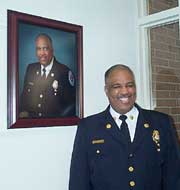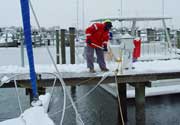 |
|||||||
|
Volume 13, Issue 4 ~ January 27 - Febuary 2, 2005
|
|||||||
|
|
Dock of the Bay
New Chief Blackwell earns an A and a portrait No more sliding down firepoles or riding a blaring fire engine. No more fire helmets, smoky evenings or hooking hoses to hydrants. But that's just fine with Ronald Blackwell, Anne Arundel County's newest and first African American fire chief. "I couldn't be more proud to be fire chief here," said Blackwell. "I feel very fortunate to have the opportunity to lead." Blackwell joined Anne Arundel County's department in September after County Executive Janet Owens wooed him from his post as chief for Prince George's County. "I found him myself, and I say that with pride, because of how strongly I feel about the Anne Arundel County Fire Department," Owens boasted. "It's first class in breadth, depth, and he understands the complexities of fire service." Anne Arundel holds its fire departments in such high regard that chiefs get their portraits done early in the job term, whereas most public officials have to first finish the job. Chief Blackwell's picture, shot by Ed Buxton of Severna Park, was unveiled this month, making him the seventh fire chief in the line of portraits on the first floor hall of the county fire department headquarters in Millersville. Poised in his crisp official fire chief's dress uniform - a black jacket with gold pins and buttons, fire chief badge and gold-ringed cuffs - Blackwell looks the image of authority. "I certainly feel like I'm living a dream," Blackwell said before helping Owens unveil the portrait. "It goes back to pushing a toy fire truck across the floor in my childhood home." The Kansas City native grew up to become a firefighter. He was a fire protection specialist for the Air Force and a deputy fire chief in Wichita, Kansas, before moving to Prince George's County. Blackwell isn't fighting fires now, but he knows the meaning of the job. "Good firefighters are people who have a real compassion and sensitivity to serve," he said. "We should always be at the service of people who have come to respect and rely on us." "Things are changing for the good," said firefighter Jeff Gellert, of the Galesville department, one of the county's 42 fire stations. "It's getting more progressive with the paramedic units." With hundreds of fire fighters depending on him to keep them safe, staffed and equipped, Blackwell feels the weight of his job. "Fire chief is one of the more important jobs, especially since September 11th," Blackwell explained. "Fire chiefs have to have responsibility for EMT, fire protection, hazardous materials, and we have a marine unit with a fire boat." So far, he's earning an A from the boss. "I'm very pleased. He's learned so much so fast," Owens said. "He's taking his time to get to know people and get to know the county." -Carrie Steele
New pool planned for Cove Point Park The children of Southern Calvert County will cool off in a new pool this summer. Under construction on Cove Point Road are a leisure pool with slides and waterfalls, an eight-lane lap pool and a kids pool for Cove Point Family Aquatic Center. How to complete the Cove Point Recreational Center, along with new parks and ballfields in the Calvert County Land Preservation, Parks and Recreation Plan, brought citizens out in January's cold and snow to plan for summer. Ballfields, a skateboard park and roller hockey and ice-skating rinks were among suggestions. "These will give teenagers at the age where you want them doing something a place to go," said Jeanine Potas, parent and county staffer, who recorded citizens' suggestions. But with no sidewalks or public transportation in Southern Calvert, parents worry about their children's safety. "There's no way to get the kids from point A to point B," said Danny Huseman, father of an 11-year-old daughter. To solve that problem, some parents wanted to add bike and walking trails to swimming pools and ballfields. Others argued that the roads are too busy and too hazardous for biking children. They sought public transportation from areas rich with children, like Chesapeake Ranch Estates and Drum Point Estates. Sidewalks would safeguard children, some suggested, noting that sidewalks planned for Lusby Town Center do not extend onto Cove Point Road or to the recreational center. Farther south, another large-scale recreation area, to be known as Solomons Town Center Park, is under planning for 20 acres recently acquired adjacent to Annmarie Garden. As well as bike and in-line skating trails, an amphitheater for local musicians and to display works by local artists were suggested for that park. At Annmarie Garden, an outdoor theater similar to the one at Calvert Marine Museum is in the works, according to Parks and Recreation chief Doug Meadows. Needed around the county are more ballfields as well as lights at existing fields. Opening Patuxent High School gym to the public in the summer was also suggested, along with more space for pick-up sports. Finishing the new 10-year plan for land preservation and recreation allows Calvert to receive state Open Space funds. Suggestions are welcome until February 11. E-mail comments to [email protected] or mail to Jenny Plummer-Welker at County Planning and Zoning, 175 Main Street, Prince Frederick, 20678. -Carol Swanson
How boat-dwellers stay warm in wind, ice, snow events For year-round live-aboard boat people, WISE-dom is not a good thing. WISE is our age of acronym's short form of Wind, Ice, Snow Events. Worst of all is a full WISE, as occurred this past weekend, in contrast to a partial WISE, which might include only snow and ice but no wind. Live-aboards are obviously outdoor types, and they have to be wise to what WISE can do. Snow alone isn't a big deal. It's pretty, and stays cleaner on boats and docks because there's no car traffic and no chemical treatment. It may mean shoveling and sweeping the dock but not the snow on top of the boat - that's added insulation. Some boats have built-in heat, but it's rarely adequate in severe weather, so nearly all boaters have kerosene, ceramic or other auxiliary heat sources. Thus a warm coat of snow can be welcome. When a storm brings really cold weather, ice adds to the challenge. In the shallows of marinas, the water will freeze more quickly. Dirt dwellers generally only have to worry about frozen water pipes. But serious icing can damage hulls. Hence the wise boater, live-aboard or not, will have an ice-eater, which is an impellor suspended under the boat that draws warmer water from the depths and circulates it upward, thereby keeping the water liquid around the boat for several feet. Water issues can be more pressing during a full WISE if the temperature plummets. During the winter when regular dock water lines are shut down, on-board tanks are filled from hoses running in the water under the dock, low enough where they won't freeze. They have nozzles spaced along the way, and rope lines attached. To get fresh H2-0, a sailor pulls up the line, attaches a hose to the nozzle and fills the tank. While the tanks seldom freeze, the plumbing inside can. Just like land dwellers, sailors sometimes have to let water drip from a faucet. Heat and snow can be managed, but the wind can't. It's a cruel fate that sailors face in a full WISE. Wind, our best friend in summer, becomes our enemy in winter, at its worst when combined with snow and ice. The nastiest winter winds here come from north, northwest or northeast. Ignorant of the tides, they blow the water down and out of the Bay, so boats sit as much as five or six feet lower than normal for lack of water. It's really tough to get off the boat when the dock is a half-story above you. "My sink froze, but it defrosted itself fairly quickly," said Capt. Marty Schultz, basin director at Maryland Yacht Club. "The big problem for me was not being able to get off the boat, particularly to walk Buffles" [his dog]. Apart from the inaccessible height of the dock, winter storm winds pitch rather than rock the boat, which makes a dicey balancing act for egress. Just say no to going ashore. A full WISE also increases the likelihood of power outages. Even insulated boats don't hold heat for long in extreme storm conditions, so live-aboards have to be prepared to make heat and food with a generator or other energy source. But it's a measure of a sailor's mettle to play backgammon by the light of a pitching lantern in a boat with an inside temperature of 54. Is this really wise? Depends, perhaps, on the definition. -Alice Snively Roaming On and Off the Range
Ask the P Come-Back Trees In Washington, low-power FM radio broadcasters - among them Anne Arundel-based WRYR - and wannabes will testify in front of the FCC on February 8 about their experiences since a new round of low-power licenses was granted five years ago. Learn about workshops etc. on the day before by emailing [email protected]. ... |
||||||




 lant ProfessorWinter Blooms and Spring Dreams
lant ProfessorWinter Blooms and Spring Dreams In Philadelphia, Coast Guard officials testifying at a congressional hearing last week still don't know what harpooned the Athos I oil tanker in the Delaware River in November, creating a devastating spill. It could have been a pipe from a huge pump, an anchor or perhaps even a slab of concrete that caused 265,000 gallons of heavy crude to ooze out, they said ...
In Philadelphia, Coast Guard officials testifying at a congressional hearing last week still don't know what harpooned the Athos I oil tanker in the Delaware River in November, creating a devastating spill. It could have been a pipe from a huge pump, an anchor or perhaps even a slab of concrete that caused 265,000 gallons of heavy crude to ooze out, they said ...